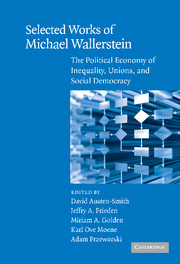 Selected Works of Michael Wallerstein
Selected Works of Michael Wallerstein Published online by Cambridge University Press: 27 January 2010
How do changes in the inequality of income affect political support for welfare policy? Starting with the economic models of Romer (1975), Roberts (1977), and Meltzer and Richard (1981), the conventional view is that increased inequality in pretax earnings leads to greater political demand for redistributive policies. The logic is simple and compelling. If the majority of the electorate receives a below-average income and if an increase in inequality causes above-average incomes to rise and below-average incomes to fall, then it is reasonable to think that demands for public policies to reduce the gap between rich and poor will increase.
The argument of Romer (1975) and Meltzer and Richard (1981) is best illustrated by comparing two hypothetical lognormal income distributions with the same mean but different levels of inequality as shown in Figure 1. As the figure shows, the greater the variance of a distribution like the lognormal distribution that is skewed to the right, the greater the gap between median and mean income. In the models of Romer (1975), Roberts (1977), and Meltzer and Richard (1981), political competition drives the level of welfare spending toward the ideal point of the median income voter. The greater the gap between the pretax earnings of the median income voter and average (mean) income, the greater is the level of spending preferred by the median income voter and the higher is the equilibrium level of welfare spending.
To save this book to your Kindle, first ensure [email protected] is added to your Approved Personal Document E-mail List under your Personal Document Settings on the Manage Your Content and Devices page of your Amazon account. Then enter the ‘name’ part of your Kindle email address below. Find out more about saving to your Kindle.
Note you can select to save to either the @free.kindle.com or @kindle.com variations. ‘@free.kindle.com’ emails are free but can only be saved to your device when it is connected to wi-fi. ‘@kindle.com’ emails can be delivered even when you are not connected to wi-fi, but note that service fees apply.
Find out more about the Kindle Personal Document Service.
To save content items to your account, please confirm that you agree to abide by our usage policies. If this is the first time you use this feature, you will be asked to authorise Cambridge Core to connect with your account. Find out more about saving content to Dropbox.
To save content items to your account, please confirm that you agree to abide by our usage policies. If this is the first time you use this feature, you will be asked to authorise Cambridge Core to connect with your account. Find out more about saving content to Google Drive.